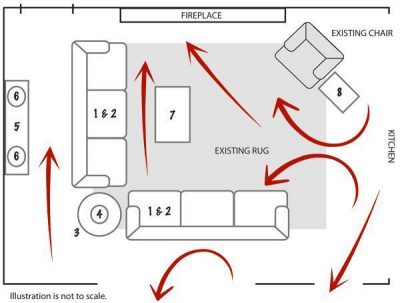How to Arrange Furniture- 10 Basic Rules
Planning the arrangement of furniture is hard enough when you are buying new furniture to fill a house for the first time. It becomes even more challenging when you are moving a houseful of furniture from an existing home into a new space. It may take a while to get a feel for the new space and figure out how to make the rooms both comfortable and functional. And you need to be ready to rearrange, get rid of pieces that don’t fit, and perhaps purchase new items that might work a little better than your old pieces.
If possible, give careful consideration to the arrangement of furniture in the new space well before you move. This advance planning can make the arrangement go much smoother when moving day comes, and it might even prevent you from moving furniture that is not going to work in the new space, anyway. If a couch is destined to be given or thrown away, why go through the labor and expense of moving it from the old house to the new?
Over the years, interior designers have recognized a number of simple, easy-to-apply principles that work. Just follow these common sense rules and you’ll find that arranging furniture isn’t so scary after all.
1. Think About How the Room Will Function
Consider how the room is used and how many people will use it. That will dictate the type of furnishings you will need and the amount of seating required.
2. Decide on a Focal Point
Identify the room’s focal point — a fireplace, view, television — and orient the furniture accordingly. If you plan to watch television in the room, the ideal distance between the set and the seating is three times the size of the screen (measured diagonally). Therefore, if you’ve got a 40-inch set, your chair should be 120 inches away.
3. Start With Priority Pieces
Place the largest pieces of furniture first, such as the sofa in the living room or the bed in the bedroom. In most cases this piece should face the room’s focal point. Chairs should be no more than 8 feet apart to facilitate conversation. Unless your room is especially small, avoid pushing all the furniture against the walls.
4. Consider Symmetry
Symmetrical arrangements work best for formal rooms. Asymmetrical arrangements make a room feel more casual.
5. Create a Traffic Flow
Think about the flow of traffic through the room — generally the path between doorways. Don’t block that path with any large pieces of furniture if you can avoid it. Allow 30 to 48 inches of width for major traffic routes and a minimum of 24 inches of width for minor ones.
Try to direct traffic around a seating group, not through the middle of it. If traffic cuts through the middle of the room, consider creating two small seating areas instead of one large one.
6. Aim for Variety
Vary the size of furniture pieces throughout the room, so your eyes move up and down as you scan the space. Balance a large or tall item by placing another piece of similar height across the room from it (or use art to replicate the scale). Avoid putting two tall pieces next to each other.
7. Build in Contrast
Combine straight and curved lines for contrast. If the furniture is modern and linear, throw in a round table for contrast. If the furniture is curvy, mix in an angular piece. Similarly, pair solids with voids: Combine a leggy chair with a solid side table, and a solid chair with a leggy table.
8. Design for Ease of Use
Place a table within easy reach of every seat, being sure to combine pieces of similar scale, and make sure every reading chair has an accompanying lamp. Coffee tables should be located 14 to 18 inches from a sofa to provide sufficient legroom.
9. Allow for Circulation
In a dining room, make sure there’s at least 48 inches between each edge of the table and the nearest wall or piece of furniture. If traffic doesn’t pass behind the chairs on one side of the table, 36 inches should suffice.
In bedrooms, allow at least 24 inches between the side of the bed and a wall, and at least 36 inches between the bed and a swinging door.
10. Do Your Planning
Give your back a break. Before you move any furniture, test your design on paper. Measure the room’s dimensions, noting the location of windows, doors, heat registers and electrical outlets, then draw up a floor plan on graph paper using cutouts to represent the furnishings. Or, better yet, use a digital room planner to draw the space and test various furniture configurations. It’s less work and a lot more fun.




 Kim N. Bregman
Kim N. Bregman